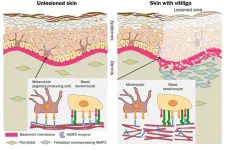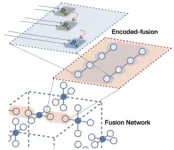(Press-News.org) In hospital operating rooms and intensive care units, propofol is a drug of choice, widely used to sedate patients for their comfort or render them fully unconscious for invasive procedures.
Propofol works quickly and is tolerated well by most patients when administered by an anesthesiologist. But what is happening inside the brain when patients are put under and what does this reveal about consciousness itself?
Investigators at U-M who are studying the nature of consciousness have successfully used the drug to identify the intricate brain geometry behind the unconscious state, offering an unprecedented look at brain structures that have traditionally been difficult to study.
“Consciousness has been the subject of study from various perspectives and understanding the neurobiological foundations of consciousness carries major implications of multiple medical disciplines such as neurology, psychiatry and anesthesiology,” said Zirui Huang, Ph.D., Research Assistant Professor in the Department of Anesthesiology at U-M Medical School.
To date, researchers have debated about how anesthetics suppress consciousness. Specifically, whether the site of action lies primarily in the thalamus, an egg-shaped structure deep within the brain, which receives information from what we see, touch and hear, or in the cerebral cortex, which processes that information in complex ways.
A new study published in the journal Nature Communications and led by Huang, George Mashour, M.D., Ph.D. and Anthony G. Hudetz, Ph.D., of the U-M Center for Consciousness Science outlines for the first time in humans how the connections among brain cells within those two important areas are modified by propofol.
In healthy volunteers, they mapped changes in the brain’s architecture before, during and after propofol sedation, guided by functional magnetic resonance imaging (fMRI). This enabled them to monitor blood flow to areas of the brain as the study participants entered and exited an unconscious state.
At baseline, explained Huang, the thalamus has a balanced level of activity of both specific nuclei (clusters of brain cells) that send sensory information to highly defined areas of the cortex—known as unimodal processing--and nonspecific nuclei that send information more diffusely throughout a higher layer of the cortex, known as transmodal processing.
The team found that, under deep sedation, the thalamus showed a drastic reduction in activity in clusters of brain cells responsible for transmodal processing leading to a dominant unimodal pattern—suggesting that while sensory inputs are still received, there is no integration of those inputs.
“The field has been focusing on anesthetic effects in the thalamus and cortex for more than two decades—I believe this study significantly advances the neurobiology” said George Mashour, M.D., Ph.D., Professor of Anesthesiology and Pharmacology, and founder of the U-M Center for Consciousness Science.
Next, they discovered the specific cell types that played a role in the shift to an unconscious state and their relationship to the change in thalamic processing. The thalamus contains at least two distinct cell types, said Huang, core cells and matrix cells.
“We now have compelling evidence that the widespread connections of thalamic matrix cells with higher order cortex are critical for consciousness,” says Hudetz, Professor of Anesthesiology at U-M and current director of the Center for Consciousness Science.
Imagining that the cortex is layered like an onion, core cells connect to lower layers while matrix cells connect to higher layers in a more spread-out manner. By measuring mRNA expression signatures—like I.D. badges for the cells—they were able to see that a disruption in the activity of matrix cells played a greater role in the transition to unconsciousness than core cells. An additional surprise was that GABA, a major inhibitory transmitter in the brain usually thought to be key to propofol’s actions, did not appear to play as prominent a role as expected.
“The results suggest that loss of consciousness during deep sedation is primarily associated with the functional disruption of matrix cells distributed throughout the thalamus,” said Huang.
Paper cited: “Propofol Disrupts the Functional Core-Matrix Architecture of the Thalamus in Humans,” Nature Communications. DOI: 10.1038/s41467-024-51837-1
END
How the brain's inner chamber governs our state of consciousness
University of Michigan researchers use propofol to uncover the interactions between the thalamus and cortex that underlie consciousness
2024-09-09
ELSE PRESS RELEASES FROM THIS DATE:
Can coping with a cancer diagnosis contribute to psychological and cardiovascular problems in family members?
2024-09-09
New research suggests that a family member’s cancer diagnosis may increase first-degree relatives’ and spouses’ risks of developing psychological and cardiovascular illnesses. The findings are published by Wiley online in CANCER, a peer-reviewed journal of the American Cancer Society.
Having a family member diagnosed with cancer can be a stressful and traumatic experience for the entire family. Because stress influences not only mental health but also cardiovascular health, investigators explored whether a cancer diagnosis contributes ...
Loss of skin’s pigment-producing cells could be related to basement membrane disruption
2024-09-09
Skin pigmentation disorders affect people across the world. One of them, vitiligo, is said to have a worldwide incidence of 1-2%. What causes the loss of pigmentation in vitiligo has long been unclear, but an Osaka Metropolitan University-led team has uncovered clues to the mechanism behind the disorder.
In findings published in The Journal of Pathology, Graduate School of Medicine Specially Appointed Associate Professor Lingli Yang, the corresponding author, and researchers including Specially Appointed Professor Ichiro ...
Developed proprietary quantum error correction technology beyond the world's leading quantum computing companies
2024-09-09
Solving the problem of error is essential for the practical application of quantum computing technologies that surpass the performance of digital computers. Information input into a qubit, the smallest unit of quantum computation, is quickly lost and error-prone. No matter how much we mitigate errors and improve the accuracy of qubit control, as the system size and computation scale increase, errors accumulate and algorithms become impossible to perform. Quantum error correction is a way to solve this problem. As the race for global supremacy in quantum technology intensifies, most major companies and research groups leading the development of quantum ...
AI will surpass human brains once we crack the ‘neural code’
2024-09-09
Humans will build Artificial Intelligence (AI) which surpasses our own capabilities once we crack the ‘neural code’, says an AI technology analyst.
Eitan Michael Azoff, a specialist in AI analysis, argues that humans are set to engineer superior intelligence with greater capacity and speed than our own brains.
What will unlock this leap in capability is understanding the ‘neural code’, he explains. That’s how the human brain encodes sensory information, and how it ...
RSV vaccination in older adults with health conditions is cost-effective
2024-09-09
Targeting vaccination programs for respiratory syncytial virus (RSV) to older adults with underlying health conditions is a cost-effective way to reduce disease, according to a new modelling study https://www.cmaj.ca/lookup/doi/10.1503/cmaj.240452 in CMAJ (Canadian Medical Association Journal).
RSV infections cause major illness, especially in infants and older adults, and rates of infection increase with age. There are now vaccines available to prevent disease caused by RSV in adults, and vaccination campaigns may reduce the incidence in older adults and associated ...
Melanoma incidence and mortality trends in Sweden
2024-09-09
About The Study: The findings of this cohort study showed a significant recent downward trend in both melanoma incidence and melanoma mortality in the age group 30 to 49 years in Sweden. The reasons for these declines are unclear but may include UV protection, public health campaigns, changing population demographics, and the introduction of effective melanoma treatment. None of these possibilities were evaluated; further study is needed.
Corresponding Author: To contact the corresponding author, Hildur Helgadottir, MD, PhD, email hildur.helgadottir@sll.se.
To access the embargoed study: Visit our For The Media ...
Breaking the trend: Skin cancer incidence in young adults declines
2024-09-09
The risk of skin cancer, malignant melanoma, now appears to be decreasing in Sweden - at least in those under 50, according to a new study.
“We can see a trend break in young adults around 2015 where the incidence curves are falling,” says first author Hildur Helgadottir, senior consultant and associate professor of oncology at the Department of Oncology-Pathology, Karolinska Institutet.
She and her research colleagues have analyzed data from the Swedish Melanoma Registry and followed melanoma incidence and mortality for different age segments over time. This means that they have compared individuals in a certain age range at one ...
ChatGPT outperformed trainee doctors in assessing complex respiratory illness in children
2024-09-09
The chatbot ChatGPT performed better than trainee doctors in assessing complex cases of respiratory disease in areas such as cystic fibrosis, asthma and chest infections in a study presented at the European Respiratory Society (ERS) Congress in Vienna, Austria [1].
The study also showed that Google’s chatbot Bard performed better than trainees in some aspects and Microsoft’s Bing chatbot performed as well as trainees.
The research suggests that these large language models (LLMs) could be used to support trainee doctors, nurses and general practitioners to triage patients more quickly and ease pressure on health services.
The ...
Night owls are more likely to develop type 2 diabetes – and it’s not just because of an unhealthy lifestyle, Dutch study finds
2024-09-09
Night owls have a higher BMI, larger waists, more hidden body fat and are almost 50% more likely to develop type 2 diabetes (T2D) than those who go to bed earlier, new research to be presented at the Annual Meeting of the European Association for the Study of Diabetes (EASD) in Madrid, Spain (9-13 September), has found.
Lead researcher Dr Jeroen van der Velde, of Leiden University Medical Centre, Leiden, Netherlands, says: “Previous studies have indicated that a late chronotype – preferring to go to bed late and wake up later – is associated with an unhealthy lifestyle. Late chronotypes are ...
Air travel may affect insulin pump delivery in people with type 1 diabetes
2024-09-09
Altitude changes during commercial flights may affect the blood glucose levels of people with type 1 diabetes who are treated with insulin pump therapy, according to new research to be presented at this year’s Annual Meeting of The European Association for the Study of Diabetes (EASD), Madrid (9-13 Sept).
“We investigated the effect atmospheric pressure changes during flight can have on insulin pumps following concerns that glucose levels may drop below the normal ranges during or immediately after flights,” explained lead author Dr Ka Siu Fan from the Royal Surry County Hospital and University ...
LAST 30 PRESS RELEASES:
Exploring why adapting to the environment is more difficult as people age
Society for Laboratory Automation and Screening welcomes new scientific director: Madeline M. Farley, Ph.D.
Austrian cow shows first case of flexible, multi-purpose tool use in cattle
Human nasal passages defend against the common cold and help determine how sick we get
Research alert: Spreading drug costs over the year may ease financial burden for Medicare cancer patients
Hospital partnership improves follow up scans, decreases long term risk after aortic repair
Layered hydrogen silicane for safe, lightweight, and energy-efficient hydrogen carrier
Observing positronium beam as a quantum matter wave for the first time
IEEE study investigates the effects of pointing error on quantum key distribution systems
Analyzing submerged fault structures to predict future earthquakes in Türkiye
Quantum ‘alchemy’ made feasible with excitons
‘Revoice’ device gives stroke patients their voice back
USF-led study: AI helps reveal global surge in floating algae
New method predicts asthma attacks up to five years in advance
Researchers publish first ever structural engineering manual for bamboo
National poll: Less than half of parents say swearing is never OK for kids
Decades of suffering: Long-term mental health outcomes of Kurdish chemical gas attacks
Interactional dynamics of self-assessment and advice in peer reflection on microteaching
When aging affects the young: Revealing the weight of caregiving on teenagers
Can Canada’s health systems handle increased demand during FIFA World Cup?
Autistic and non-autistic faces may “speak a different language” when expressing emotion
No clear evidence that cannabis-based medicines relieve chronic nerve pain
Pioneering second-order nonlinear vibrational nanoscopy for interfacial molecular systems beyond the diffraction limit
Bottleneck in hydrogen distribution jeopardises billions in clean energy
Lung cancer death rates among women in Europe are finally levelling off
Scientists trace microplastics in fertilizer from fields to the beach
The Lancet Obstetrics, Gynecology, & Women’s Health: Taking paracetamol during pregnancy does not increase risk of autism, ADHD or intellectual disabilities, confirms new gold-standard evidence review
Taking paracetamol during pregnancy does not increase risk of autism, ADHD or intellectual disabilities
Harm reduction vending machines in New York State expand access to overdose treatment and drug test strips, UB studies confirm
University of Phoenix releases white paper on Credit for Prior Learning as a catalyst for internal mobility and retention
[Press-News.org] How the brain's inner chamber governs our state of consciousnessUniversity of Michigan researchers use propofol to uncover the interactions between the thalamus and cortex that underlie consciousness


